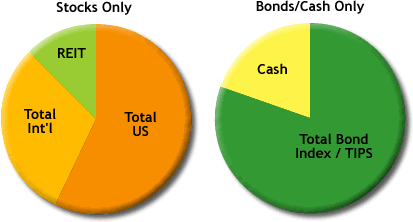(This is the fifth in my series of Model Portfolio Comparisons.)
First written in 1973, Burton Malkiel’s A Random Walk Down Wall Street (my review) has become an investing classic, pioneering the controversial idea that stock prices are random and thus a monkey throwing darts would be just accurate as any stock-picker. Below is a recommended asset allocation from the book for an investor in their “mid-twenties”.
Bold Investor Model Portfolio

Asset Allocation for suggested 75% Stocks/25% Bonds ratio
43% Total US Stock Market
22% Total International Stock Market
10% REIT
20% Treasuries/TIPS/High-Quality Corporate Bonds
5% Cash
This breakdown looks very similar to the basic “Early Saver” portfolio from All About Asset Allocation. See the rest of the model portfolios for example mutual funds and ETFs for each asset classes.
As you age, the recommended percentage of stocks goes down to 65% at age 40 and 40% in late retirement. It is interesting to note that while Malkiel consistently recommends real estate as part of your portfolio, REITs were not explicitly included in the recommended portfolios until recently. I noticed this when comparing my personal copy (published in 1996) to the most recent edition. I’m guessing the growing availability of index funds that track REITs is the reason behind this.
 The Best Credit Card Bonus Offers – 2025
The Best Credit Card Bonus Offers – 2025 Big List of Free Stocks from Brokerage Apps
Big List of Free Stocks from Brokerage Apps Best Interest Rates on Cash - 2025
Best Interest Rates on Cash - 2025 Free Credit Scores x 3 + Free Credit Monitoring
Free Credit Scores x 3 + Free Credit Monitoring Best No Fee 0% APR Balance Transfer Offers
Best No Fee 0% APR Balance Transfer Offers Little-Known Cellular Data Plans That Can Save Big Money
Little-Known Cellular Data Plans That Can Save Big Money How To Haggle Your Cable or Direct TV Bill
How To Haggle Your Cable or Direct TV Bill Big List of Free Consumer Data Reports (Credit, Rent, Work)
Big List of Free Consumer Data Reports (Credit, Rent, Work)
John Bogle and others have said that REITs are not needed because they are already included in the allocation as long as you are buying “total stock market”. The “total” part means you already have REITs and it would not be of any benefit to overweight them through REIT funds.
At first I believed that Malkiel was one of those people who followed that school of thought, but had recently changed his mind and converted to those that treat it as a separate asset class due to it’s low correlation with other assets. Not that either theory is right or wrong, but it would have been interesting if a prominent figure did such a “flip-flop”.
But upon comparing the older and newer editions he seems to always have recommended real estate holdings above what is included in the total market. From what I read, he was simply unsatisfied with the REIT investment vehicles available at that time (pre-1996). For example, the Vanguard REIT index fund only came into existence in mid-1996.
Forget Malkiel, Berstein, etc… Just get yourself a bevy of bunnies: link
Most people own a home, and that’s nontrivial exposure to the real estate market already. You could consider that part of your “portfolio”.
(Not that it’s really diversified, or that stuffing money into a home for investment returns is the best plan, but it’s still real estate exposure.)
Was looking at Malkiel’s latest edition today and he’s upped the equities allocation to 70%, to be split as follows:
One-half to a broad based US Index;
One-fourth to Emerging Markets Index Fund;
One-fourth to Developed Markets Index Fund.
Prior editions were more US heavy.
Owning you own home is not the same as owning real estate investment trusts. Your house is both ill-liquid and is not diversified. They have a low correlation with both equities and high quality fixed income and they have generated higher returns than the total stock market using NAREIT Equity Index which goes back to 1973.